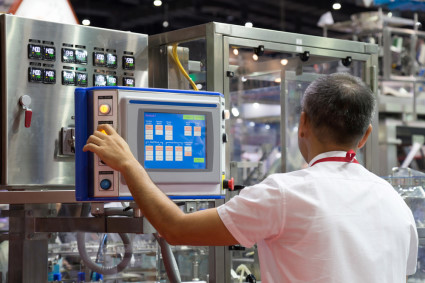Design considerations for Human Machine Interfaces
Deciding to purchase and install a Human Machine Interface (HMI) can be an expensive exercise if not undertaken with due diligence, so it’s important to select one that is suitable for your application. With a range of different hardware options to choose from, it can be overwhelming to know what to start looking for. Here, we look at size, environmental conditions, materials, IP ratings and outdoor considerations that you need to think about during the initial design process.

Size
Human Machine Interface (HMI) panels come in a wide range of brands, sizes and resolution options, so selecting the right HMI is often difficult as it comes down to a multitude of choices.
Operators often prefer to have the largest display screen size possible as it’s easier to view, especially from a distance. A lot more relevant information can be displayed per page on a larger screen including current process state of multiple systems along with alarm status, so less time is spent scrolling through different screens than if the HMI was smaller.
Downsides of a larger HMI panel is they take up more space when mounted on control panel doors, especially if they need to be installed at a suitable working height for employees, larger HMI panels can also become much more expensive depending on things such as resolution requirements.
When selecting a display size, it is important to consider the requirements of the application. Some applications will require a large display screen with high resolution to allow for detailed graphics that is monitored constantly, while other HMIs may only need a small LCD or black and white text display for basic information which is viewed infrequently.
HMIs can have a keypad or touch style, similar to a tablet or smartphone, or a combination of both.
Operators need to select a size that balances their personal preference with the application requirements while considering available installation space, cost and potential upgrade paths in future.

Environmental conditions
The environment, including what the expected operating temperature will be, should always be taken into consideration when selecting a suitable HMI. If the HMI is located in a water treatment plant, food manufacturing facility or other places where it may come in contact with water or high humidity, the HMI will need to have a suitable IP rating.
In applications where there is dust, excessive vibration or corrosive elements present, a more robust HMI or other protection options will need to be explored. It is also important to consider whether the HMI is located in an area where sunlight is present, either partially during the day or in full sun, as this will cause visibility and additional heat issues.
The following are environmental conditions that need to be considered.
Temperature ranges
Standard HMIs generally have an operating temperature range between 0…55°C, which is usually fine for a majority of applications where the HMI is located indoors in an environmentally controlled room away from heat sources. There are more rugged HMIs available that have extended operating temperature ranges in the region of -25…65°C, however the range of options are a lot more limited due to the adverse effects on adhesives, electronic components and plastic films.
Plastic films and pressure sensitive acrylic adhesives, for example, are not suitable for temperatures below freezing as they become very brittle. These need to be able to flex when switch areas are pressed, which requires high force at very low temperatures. Acrylic adhesive sheer and peel strength decrease rapidly in these temperatures, resulting in fracturing and failure.
In contrast, temperatures above 65°C causes acrylic adhesives to soften, allowing it to move under pressure or stress and cause visible bubbles on the surface. Higher temperatures can also accelerate some chemical processes including oxide formation and silver mitigation.
Water resistance
HMIs that are in environments where they might get wet require exposed edges to be sealed to ensure they are adequately IP rated. The seals need to be compliant across a range of temperatures as well as from shock and vibration.
Pooled water may still enter the smallest hole in the seal if there is an atmospheric pressure difference between the inside and outside. Pooled water, inside or on the exterior surface, causes a problem if temperatures drop below freezing as it will cause the liquid to freeze, which can further weaken sealed areas due to expansion. Further issues arise if any liquid pooling inside the HMI contains dissolved contaminants as these could cause premature failure.
Outdoor UV exposure
Exposure to outdoor UV light (sunlight) will be destructive for HMI graphic overlays made from polyester and polycarbonate. These plastic films will turn yellow and become brittle over time and due to the flex built into graphic overlays, they will quickly fracture.
If the application requires the HMI to be outdoors and exposed to UV light, a specialty UV hard coat should be used. These are rated for UV exposure and are made from polyvinyl fluoride and polycarbonate composite.
Airborne contamination
Airborne contamination such as dirt or dust can enter the user interface through the front, sides or back if not sealed correctly, increasing the likelihood of premature failure. To prevent airborne contamination affecting the HMI operation, a completely environmentally sealed unit would need to be considered.
Chemical contamination
Chemical contamination in the form of unintended splashes or other airborne exposure can degrade exterior surfaces at the edges of the HMI, as well as any switch contact surfaces which can cause failure of the underlying mechanisms.
Abrasion resistance
Abrasion damage can be caused by hard surfaces coming in contact with soft surfaces. For example, soft display windows can be damaged by fingernails or tools, graphic overlays can be damaged if gloves or hands have grit on them, also rubber keytops and bezel around keypads can be damaged by dirt and grit.
Abrasion can be reduced through material selection such as using UV hard coats and polyurethane, training should also be provided to highlight how best to use the HMI where there is a risk of abrasion damage.
Vibration and shock
HMIs are typically mounted in low shock and low vibration environments, however the equipment and connectors they are attached to may not be. Vibration and shock can cause the connector and cables that plug into the user interface to damage the assembly.
Visibility
HMIs come in a variety of options for screen resolution as well as viewability based on the ambient light. Many screens cannot be easily read in sunlight, so if the HMI is intended to be used outdoors or in bright locations, specific sun-readable screens may need to be considered.

Materials and IP rating
While there are many environmental conditions that can cause damage to an HMI, products manufactured from appropriate materials and with the correct IP rating will ensure the HMI can withstand the various site conditions.
IP ratings are important as they indicate the levels of sealing effectiveness against dirt, water and other foreign bodies. These are made up of two numbers, the firstt number being solids protection on a scale of 1-6, and the second number being liquids protection on a scale of 1-7, the higher the number for each category, the higher the protection.
Various materials and components can be used to achieve different IP ratings based on the requirements, as well as to protect against other environmental considerations. For example, HMI control panels constructed of stainless steel are ideal for heavy duty applications and generally offer maximum moisture protection; O-rings or gaskets can help with vibration protection; and UV screen shields made from polyvinyl fluoride and polycarbonate composite will offer protection from UV rays.
Considerations for outdoor use
When considering a HMI for outdoor use, the following should be considered:
Glare – Glare can be mitigated by choosing a HMI that is sun-readable, these HMI’s typically have a matte, anti-glare finish on the screen. Alternatively, the addition of a separate screen shield/cover should be installed to improve visibility and avoid damage to the HMI from constant sun exposure.
Moisture ingress – Ensuring the HMI has adequate water ingress protection is a major consideration for outdoor applications, as there is a high chance of moisture coming in contact with the control panel and wide variations in temperature will cause condensation to build up both on the outside and inside of the control panel.
Temperature range – An outdoor HMI is generally exposed to greater temperature variations so consideration for a model that has a wider temperature tolerance is recommended to avoid premature failure of the unit. The cost of extreme temperature HMIs are understandably higher than standard HMIs, however the longer life and robustness to the extreme HMI more than offsets the additional initial cost involved.
In the second part of this article, we continue looking at what factors you need to take into consideration when selecting a HMI from a functional and end user point of view.

